Email opening lines are the very first sentences your reader sees after opening your message – usually the first three or four lines. They play a crucial role in determining whether your email campaign succeeds. A strong opening line can hook your audience instantly, while a weak one risks losing their attention before they’ve even reached your main message.
Yes, your email subject line is what gets the email opened. But once the reader clicks in, it’s the email opening lines that decide if they’ll keep reading, click through, or simply close the tab. If those first few lines don’t feel relevant, engaging, or personal, your email engagement rate will suffer.
That’s why, in any professional email, opening lines deserve as much planning as your subject line. They should be right at the top of your email pre-send checklist, because writing effective, attention-grabbing openings is essential to building trust and driving action.
In this post, we’ll share seven email opening lines we love because they’re fresh, inspiring, and proven to grab attention. These are practical email opening lines examples you can adapt for different audiences and purposes.
1. The story-teller’s opening line
Key characteristics used:
- Story-telling
- Display of understanding human nature
Traditional stories often begin with the phrase ‘Once upon a time‘. Oral stories that people tell one-to-one often begin with ‘Picture this’. Pascio does it beautifully in one of their emails below.
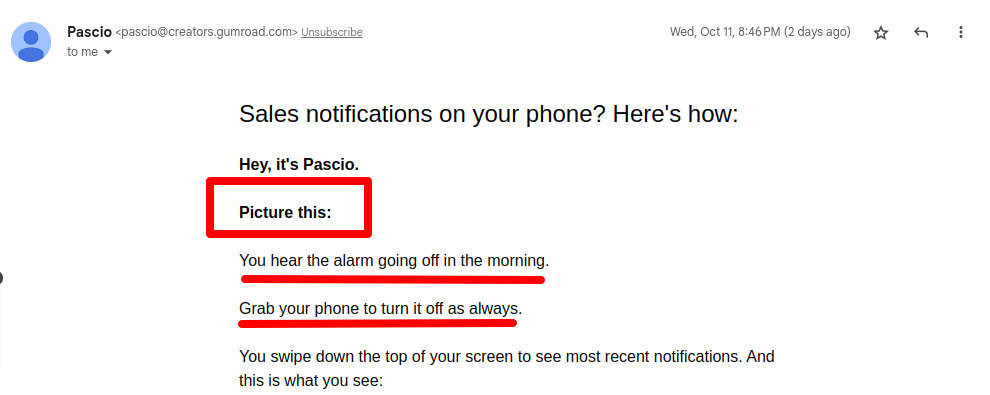
Interestingly, the best part is not the first line; it’s easy to begin this way. The part that the email below gets right is the subsequent lines – they have you nodding (who doesn’t check notifications?).
What does it do? At a subtle level, the sender knocked off any resistance you might have had. Even if you had thought ‘I’ll just read the first line and then hit ‘Delete’ immediately’, you will no longer delete the email after reading the first line.
By simply having you say ‘Yes’ at the email opening line, the sender has their foot firmly in the door.
Once they’ve got you nodding and saying Yes, there’s no way you can ignore the rest of the email. It’s because you start feeling that the sender knows you very well.
What makes it great:
- It asks you to imagine something you see on a daily basis. That’s easy, so you’ll do it – and you’re engaged.
- The opening lines have a natural flow of events we see regularly. That makes us keep reading.
Best suited for:
- Sharing case studies
- Brand story
2. The ego-and-candy style of starting the email
Key characteristics used:
- Clear display of empathy
- Human ego
Challenging the prospect, gently bringing their ego in sales is a smart technique. Paul Petrone wrote an interesting article on challenging the buyer and getting more sales.
Have a look at the small math question below:

Such questions are everywhere: on FB, Twitter, LinkedIn, WhatsApp forwards, …
You know the trick it uses: By writing “99% of the people get the answer wrong.”, such questions challenge your ego (‘Hey, I used to get straight A’s in math!’). And you find it very difficult not to attempt the question – after all, you want to show off in front of everyone.
But if the sender uses this technique in an email, it’d not get much response (maybe because there’s no one you can show off your answer to).
So Sarah Greesonbach makes an intelligent combination: She first gets your attention by tapping into your ego. But immediately after that, she makes a promise to make your workday easier.

Without the promise, such email opening lines could appear cheesy or desperate.
That’s what we call the ego-and-candy approach: you get the attention by stirring the reader’s ego and you hold their attention by offering something sweet (help, in this case).
Email campaigns that can leverage this combination often produce some of the best email opening lines for sales and get much better traction.
What makes it great:
- The opening line uses the word “challenge”. Such words motivate the reader to keep reading your email.
- Along with the ‘challenge, there’s a clear promise. It indicates the email could be worth your time. Another reason why people will continue reading this email.
Best suited for:
- Encouraging adoption of new product categories
- Inviting sign ups for webinars
3. Email opening line about a clear pain-point
Key characteristics used:
- Curiosity
The best email opening lines aren’t necessarily the funniest (though we love them too). The best ones are that intrigue you and hold your attention.
Check out the email below. It was sent by Joanna Wiebe.
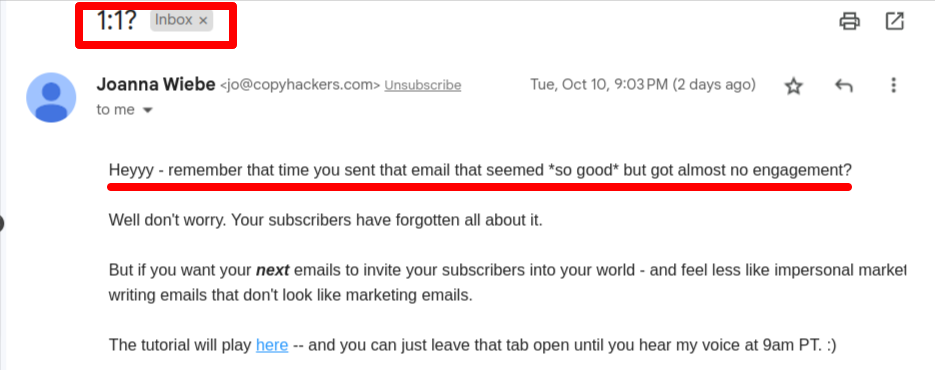
When someone like Joanna Wiebe says 1 : 1?, you sit up and take notice (‘Perhaps she’s offering free 1 : 1 sessions with a few subscribers?!’). You’ve got to read on.
The tantalizing headline doesn’t cheat you, because Joanna starts off with a very real painpoint that hurts more email marketers than you’d imagine. Email marketers are no strangers to the occasional tragedy of near-zero engagement.
As you read further, everything ties up. The denouement doesn’t fall flat, and you feel glad you read the email. Just like the subject line, the opening line of email shouldn’t make the reader feel cheated.
What makes it great:
- The opening email line mentions a pain point nearly every marketer battles.
- The friendly style of writing makes the reading part easy and conversational – another big plus.
Best suited for:
- Encouraging implementation of novel ideas
- Promoting events
4. Lines that brag – yet get love and respect
Key characteristics used:
- Establish authority
- Clearly share important updates
No one likes to pay more. So businesses often have a hard time raising prices.
And announcing the price hike is often difficult. Most organizations do it silently, and avoid attention.
But some organizations see that as an opportunity to let customers buy at the old price. And an organization like Copyblogger (sample below) builds upon this opportunity by announcing they’ve improved.

You can’t call Copyblogger modest – at least, not for this email. They are in-your-face: Copyblogger just got a *lot* better.
This, and the opening line Heads up, make the price hike announcement natural. But you think it’s fair. Because you’ve just been told that Copyblogger just got a *lot* better. So the price looks like a great bargain.
And just in case you missed the subtlety: by saying they ‘just got a lot better’ along with ‘raising our prices’, they divert the attention of the reader from pricing to understanding the improvement. Poof! With one swoosh, Copyblogger tore down the resistance to price-hike.
People might be reluctant to pay more just because your costs have risen, but people would be willing to pay you more if you’ve improved. This approach works equally well when you’re crafting professional email opening lines that need to convey authority without sounding arrogant.
What makes it great:
- The opening lines of this email have an unambiguous urgency. In emails, creating a sense of urgency improves engagement.
- In one single line, the sender has justified their price hike. That can take care of a lot of objections, given the authority the sender enjoys.
Best suited for:
- Realigning to new target markets
- Retiring dated product lines
5. Familiar objections in the email opening lines
Key characteristics used:
- Create positive shock value
- Empathy
Writing great sales emails that convert is not easy. Firstly, the open rates are low. Then, there are issues of poor engagement. And even if you begin engaging, you’ll see various objections.
That’s why the opening line of email Paige Swaffer (see below) sent out was great – it mentions an objection that even the most seasoned salespersons have trouble handling. Perfectly relatable.
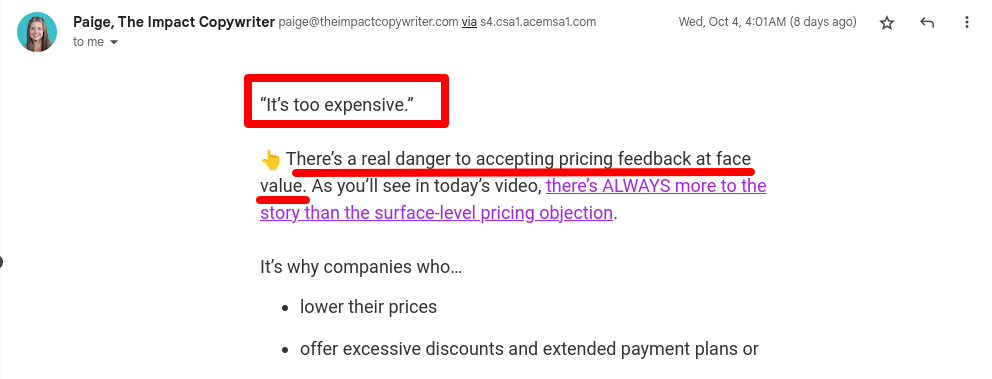
Because Paige is a great copywriter, you know that if she talks about a sales objection, she’ll have some great observations and solutions. And the next line tells you that she’s going to analyze things well, before talking about solutions.
It’s a great reminder that effective opening lines are an essential part of email marketing tips and email copywriting tips for sales teams. Who wouldn’t want to read it?
What makes it great:
- Paige starts with one of the most common sales objections. That grabs your attention like little else can.
- The next line points towards the stand the email will take. This structure makes it very easy for the reader to follow.
Best suited for:
- Startup marketing
- MOFU emails
6. An email opening line with contemporary reference
Key characteristics used:
- Relevance
- Popular culture
Here’s a newsletter we had sent to our subscribers.

This newsletter brought us our second highest engagement till date – and we know for sure the engaging email introductions in the opening lines made a difference. We started with a problem and made a clear promise. And after that, Black Panther likely caught people’s attention.
Our own newsletter aimed at helping people improve email engagement. So it was obvious that we’d first need to engage our newsletter subscribers.
The email newsletter is the longest we’ve ever, so we were naturally wary. We weren’t confident how it’d perform, whether people might appreciate its style, how the Black Panther quote might resonate with them, and so on.
Used strategically, popular culture references can significantly boost email engagement and make your message memorable.
The challenge: Using famous movie lines is a bit time-sensitive. Today, everyone can recall the movie, characters, and the line. Two years later, you want to make sure it doesn’t look a little stale.
What makes it great:
- The opening line has a unique combination of problem and promise.
- The email copy picks a famous line from a hugely successful movie and connects it to the pain point. That provides clarity to the context.
Best suited for:
- Problem aggravation in TOFU emails
- Audience that you know very well
7. A twist to ordinary email opening lines
Key characteristics used:
- Counter-intuitive
- Empathy
When you’re using email, opening lines that are intriguing can be double-edged, especially when you’re deciding how to start an email in a way that stands out.
For instance, the customer might feel you’re offering a cliched solution that likely doesn’t work anymore. Or they might think you’re going to talk about a problem without any mention of a solution.
But a skilled writer can leverage it intelligently.
This email from Animalz pulls it off very well. It starts with an oft-repeated line. But you know that Animalz knows it, which is why they’ve put it in double quotes – the second sentence confirms it.
See for yourself below.
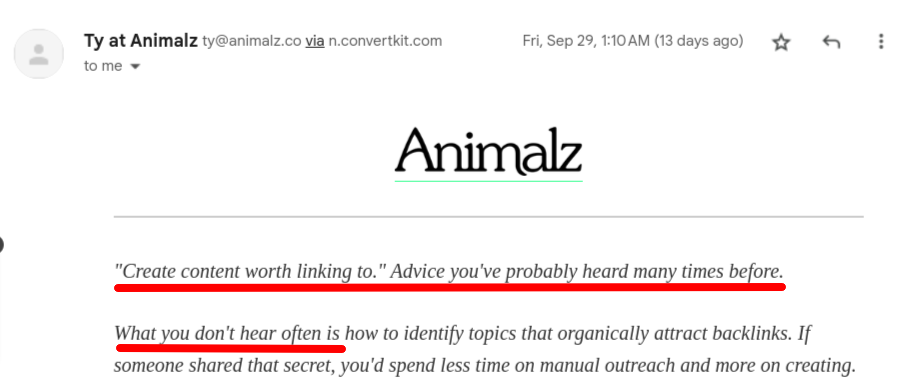
If you are reading this email, you’re probably nodding and saying, “You got it, bro! Such trite advice is a real pain in the neck!”
The next paragraph reveals Animalz knows your exact problem. Creating great content is really difficult; finding the right topic is no easy task either, considering how much content is produced on a daily basis (see the mini infographic below).
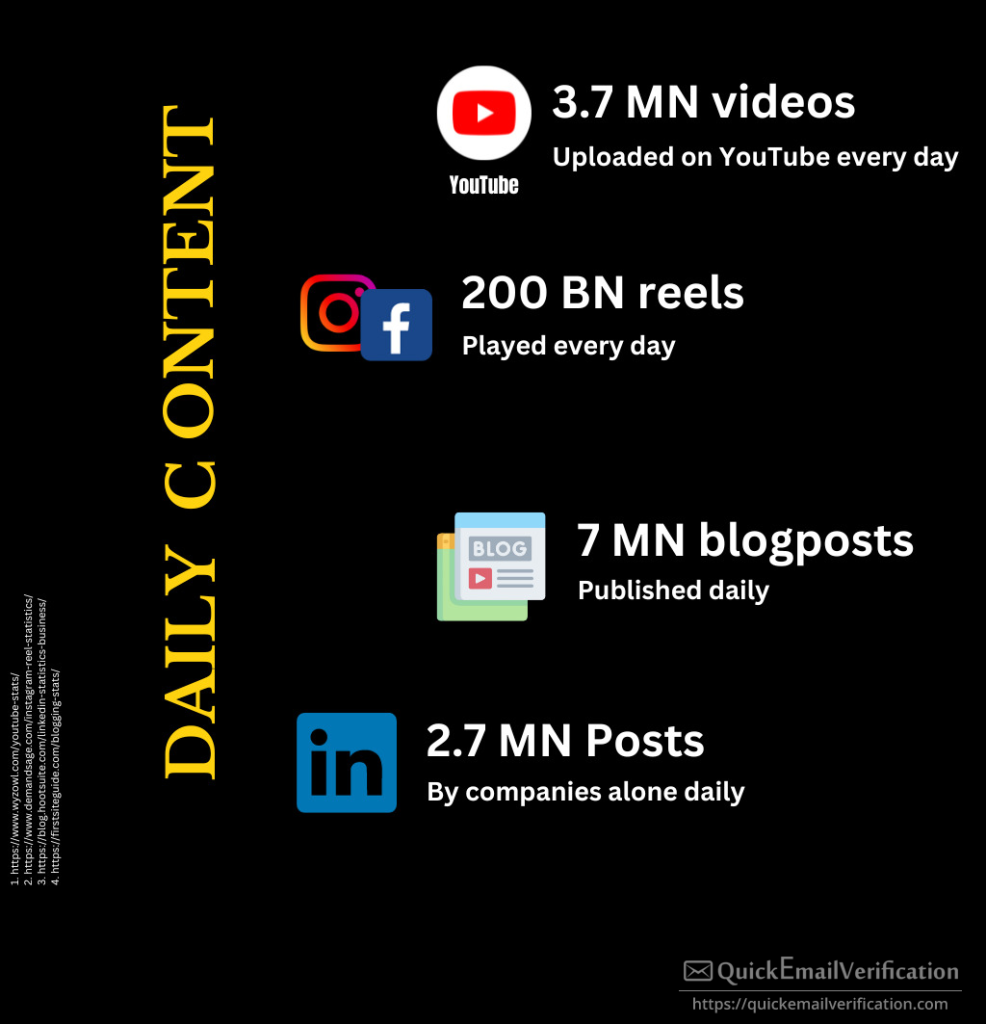
The risk factor: While we do rate these as some of the best email opening lines, it’s important to note that Animalz enjoys a certain level of respect for their content and newsletters. Which is an important reason people would continue reading the email even after reading what looks like a very ordinary opening line.
What makes it great:
- The opening lines are counter-intuitive. You almost write them off, but then you read the next line and see the point.
- The subsequent lines are what you’d call friendly email opening lines. The writer knows your pain like a friend would.
Best suited for:
- Fresh takes on traditional ideas
- Ground-breaking content and tips
Carry out this exercise with your emails
Now that you have a good idea of what makes a great email opening line, it’s time to put that learning to good use.
Go back to your past campaigns. Aligning your opening line style with your email’s objective is one of the core email marketing best practices.
Now check what kind of opening lines you’ve used. Do they fall in any of the above categories? And if yes, did the purpose align with the part we’ve mentioned under ‘Best suited for’? Make sure reviewing your opening lines is part of your email pre-send checklist so you don’t overlook this critical step.
After this exercise, list down the lessons you’ve learned. Keep them in mind when you create your next campaign. Use the analysis mentioned here to improve your email opening lines.
And watch your results soar!

